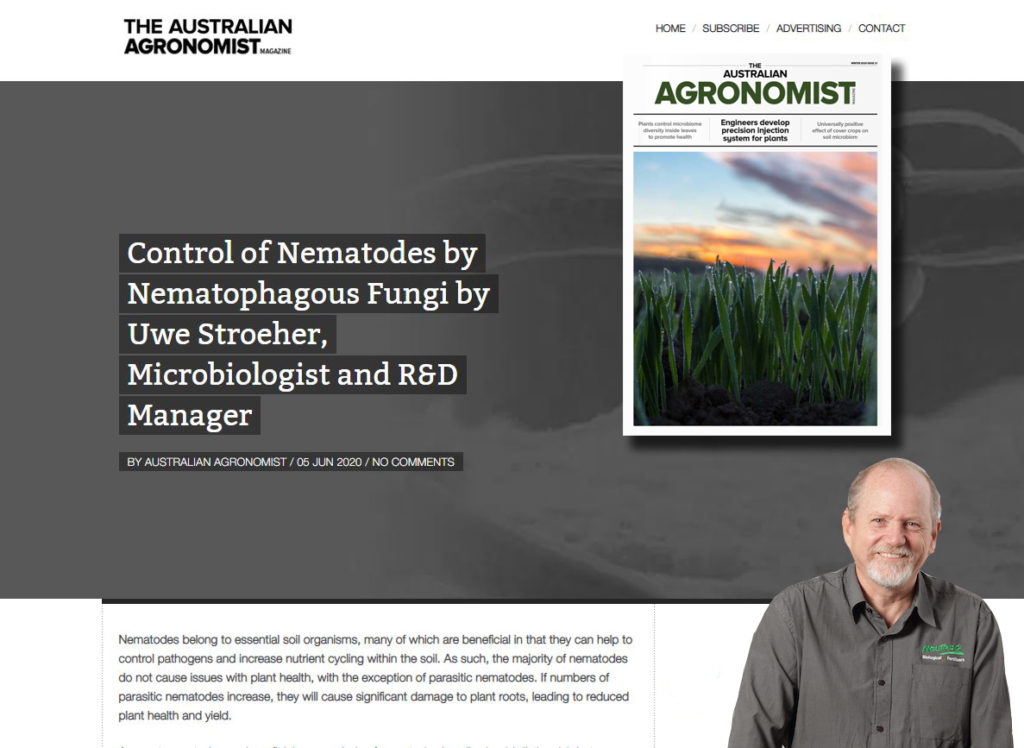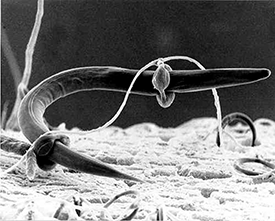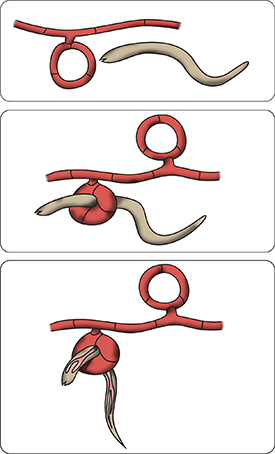
Nematodes belong to essential soil organisms, many of which are beneficial in that they can help to control pathogens and increase nutrient cycling within the soil. As such, the majority of nematodes do not cause issues with plant health, with the exception of parasitic nematodes. If numbers of parasitic nematodes increase, they will cause significant damage to plant roots, leading to reduced plant health and yield.
As most nematodes are beneficial, any analysis of nematodes in soils should distinguish between beneficial and harmful nematodes. Part of the issue with increased parasitic nematode numbers comes down to a lack of crop rotation and intensive horticultural practices, which often use large amounts of chemical fertilisers – in particular nitrogen. This is an issue which reduces the soil’s natural ability to control nematodes.
Traditional nematode control has been by soil fumigation using very toxic compounds, or alternatively by methods such as solarisation. Solarisation works well, but requires the right environmental conditions. In essence, it involves cooking the soil and therefore destroying the nematodes. It is really only usable for smaller areas. The issue with using these methods to control nematode numbers is that bacteria, fungi and other soil organisms are also killed, which essentially destroys critical soil microbial activity, and also leaves the soil open for potential pathogens.
So the important question is how we control nematode pests and yet still maintain a healthy soil biota. As part of my work as the Research & Development Manager at Neutrog fertilisers, I started to look at the literature for biological nematode controls, and as it turned out, the solution was actually right under our feet.


There are a number of bacteria which parasitise nematodes, and over 300 species of fungi which kill and digest nematodes. The fungal-killing strategies are quiet diverse, from the formation of toxins to some fungi that will grow into the mouth area and digestive tract of the nematode – in essence, digesting the nematode from the inside out. Other fungi specifically target nematode eggs or female nematodes. However, the most interesting and best studied fungi are those that trap nematodes using a range of mechanisms which I’ll discuss further on.
So these fungal species are in essence ‘nematophagous’, meaning nematode-eating. So why do the fungi specifically target nematodes? Simply put, the fungi are looking for a source of nitrogen to cover their own requirements, and nematodes represent a meal high in protein and nitrogen.
When the level of nitrogen in the soil is boosted by high level nitrogen-containing chemical fertilisers, the fungi completely switch off their nematode trapping systems because nitrogen is now freely available in the environment, which ultimately means that the use of these types of fertilisers can inadvertently increase your nematode load.
Perhaps surprisingly, using low levels of nitrogen fertilisers in the form of urea actually induces fungi to become ‘nematophagous’ or nematode-eating¹. In composted chicken litter, much of the uric acid has been converted into other forms of nitrogen-containing compounds including urea. This means that using a fertiliser based on composted chicken manure such as Neutrog’s Rapid Raiser will act to switch on the fungal nematode trapping system.
So how do fungi trap nematodes? There are two main ways in which this occurs. Some fungi produce sticky pads or branches to which the nematodes get stuck to. The other way is by fungi making rings or lassoes. The nematode swims into one of these rings which triggers the ring to quickly constrict, thereby trapping the nematode (Fig. 1). In both instances, once trapped, the fungi proceeds to infect via haustorial hyphae and digest the nematode.
Interestingly, fungi don’t build these traps for nematodes when there is no prey – the fungi can sense molecules secreted by nematodes, and the fungi will only produce traps when nematodes are present². Some fungi will even attract their nematode prey by releasing signalling molecules or fungal metabolites, which indicates to the nematode the presence of food or sexual partners³ (Fig. 2). Therefore, fungi do not simply wait for some chance encounter or build traps unnecessarily, but actively sense and attract their prey.
The question then becomes one of how we encourage these type of fungi to multiply and become part of the soil microbiota. The good things is that these trap-forming fungi are saprophytic, in that they obtain food by absorbing dissolved organic material, and as such, are not dependent on nematodes as their sole nutrient source, although in times of low nitrogen, nematodes do cover the fungal requirement of this and potentially other nutrients.

We know from various studies that nematode numbers are higher in the rhizosphere or the area around the root zone, which is perhaps not surprising considering it is the site with higher microbial biological activity compared to root free soil. However the presence of ‘nematophagous’ fungus does not always follow this rule – in some plants such as legumes, nematophagous fungus numbers are up to 20 times higher in the rhizosphere than in root free soils, whereas in cereal crops the numbers of trap-forming nematophagous fungi are about the same in the rhizosphere and the root free soil.
As mentioned earlier, the trap-forming fungi are saprophytic, so in essence they can and will use organic sources to cover their nutritional requirements. As such, the application of organic matter and, in particular, one that is nutrient balanced such as well-composted manure or chicken litter will help to support a diverse population of fungi capable of controlling nematodes.
In summary, a biological control solution does exist for parasitic nematodes, and for growers considering more sustainable farming practices, this is certainly a field which holds much promise.
References:
1. Wang X, Li GH, Zou CG, et al. Bacteria can mobilize nematode-trapping fungi to kill nematodes. Nat Commun. 2014;5:5776. Published 2014 Dec 16. doi:10.1038/ncomms6776 2. Hsueh YP, Mahanti P, Schroeder FC, Sternberg PW. Nematode-trapping fungi eavesdrop on nematode pheromones. Curr Biol. 2013;23(1):83-86. doi:10.1016/j.cub.2012.11.035 3. Hsueh YP, Gronquist MR, Schwarz EM, et al. Nematophagous fungus Arthrobotrys oligospora mimics olfactory cues of sex and food to lure its nematode prey. Elife. 2017;6:e20023. Published 2017 Jan 18. doi:10.7554/eLife.20023
